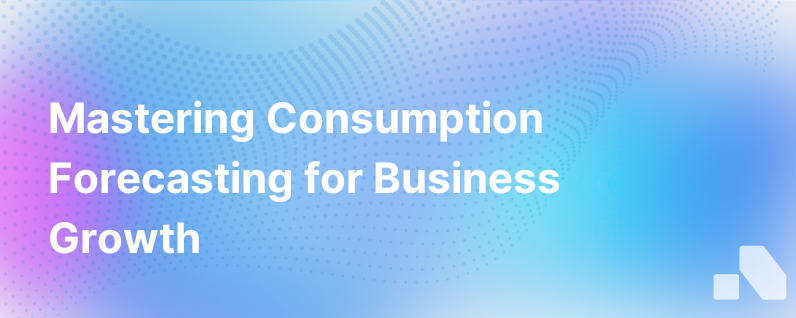
For businesses in many industries, consumption forecasting serves as the circulatory system that keeps the heart of commerce pumping. A business's ability to predict customer behavior and product usage with accuracy isn't just a tactical advantage – it's an essential component of strategic planning, financial stability, and long-term growth. In this comprehensive article, we will explore the various dimensions of consumption forecasting, its paramount significance to contemporary business practices, and strategies to enhance its accuracy and utility.
Understanding Consumption Forecasting
First and foremost, consumption forecasting refers to the process of predicting the future demand for products or services based on historical data, market trends, and statistical modeling. It allows businesses to anticipate how much of a product will be used by their customers, enabling them to manage inventory levels, streamline operations, and make informed decisions about production and purchasing.
In the world of B2B sales, the complexity of this task increases exponentially. Unlike B2C industries where individual consumer behavior can often be erratic yet statistically predictable in aggregate, B2B consumption patterns are influenced by a confluence of strategic business decisions, market forces, and operational exigencies.
The Importance of Accurate Consumption Forecasting
Precise consumption forecasting helps businesses in numerous ways, such as:
-
Inventory Management: Proper forecasting can dramatically reduce the costs associated with overstocking or understocking inventory by aligning purchase orders with the predicted consumption.
-
Cash Flow Management: Insight into future consumption allows for more accurate revenue predictions, aiding in efficient financial planning and budget allocation.
-
Meeting Customer Expectations: Knowing when and how much of a product will be needed ensures that customer demand is met consistently, bolstering satisfaction and loyalty.
-
Production Scheduling: Manufacturers can more efficiently allocate resources and labor when they have a clearer picture of forthcoming demand.
-
Risk Mitigation: By forecasting downturns in consumption, businesses can implement strategies to mitigate their impact, such as diversifying product offerings or adjusting pricing strategies.
The Struggle with Traditional Forecasting Methods
Traditional consumption forecasting methods range from simple qualitative assessments to complex quantitative models. Qualitative methods, such as the Delphi technique, rely on expert opinions, while quantitative methods, like time series analysis or causal models, depend on numerical data.
Despite the depth and variety of these approaches, traditional forecasting has its limitations. Notably, it's inherently reactive; it relies heavily on patterns of the past to predict the future. Additionally, traditional methods often struggle to incorporate and analyze the breadth of variables in today's dynamic markets, such as real-time shifts in consumer sentiment, emerging technologies, or sudden market disruptions.
Next-Generation Forecasting with AI and Machine Learning
To overcome these hurdles, progressive businesses are now turning towards cutting-edge technologies like artificial intelligence (AI) and machine learning (ML) for their forecasting endeavors. These tools offer a proactive approach to consumption forecasting by continuously learning from new data and refining predictions.
For instance, AI algorithms are capable of processing massive datasets at high velocity, uncovering hidden correlations, and adapting to market changes in real-time. Machine learning models, particularly those employing deep learning, can forecast consumption with a greater degree of precision by detecting complex nonlinear patterns that traditional statistical models might overlook.
Integrating Advanced Consumption Forecasting into B2B Sales
The incorporation of AI and ML into consumption forecasting is particularly consequential for B2B sales where the stakes are high and the margins for error low. B2B transactions often involve larger financial commitments, longer sales cycles, and more intricate supply chains compared to B2C interactions. This sector indeed stands to gain substantially from improved forecasting accuracy.
As businesses look to unlock this potential, platforms such as Aomni become invaluable allies. By utilizing advanced analytics and AI-driven insights, these platforms empower B2B sales teams to generate real-time account research, actionable competitive insights, and personalized sales content in mere minutes.
Practical Steps for Improving Consumption Forecasting
Data Quality
A forecast is only as reliable as the data it's predicated on. Ensuring that data is accurate, current, and relevant is foundational.
Collaboration Across Departments
Cross-functional collaboration ensures that the forecast reflects diverse perspectives and information sources, such as sales, marketing, operations, and customer service.
Market Analysis
A thorough analysis of market conditions, regulatory impacts, and competitive landscapes can provide context that enhances the predictive power of your consumption model.
Continuous Refinement
Regularly reviewing and adjusting forecast models allows businesses to learn from inaccuracies and refine methodologies.
Leveraging Expertise
Combining the insights generated from advanced AI platforms with human expertise often yields the best outcomes.
Conclusion
In conclusion, harnessing the power of AI and machine learning for consumption forecasting represents not just an improvement to existing processes but a paradigmic transformation for B2B businesses. With sophisticated platforms like Aomni, businesses can access a new horizon of predictive accuracy, driving strategic business decisions and facilitating robust growth. As B2B sales landscapes continue to evolve, those who wield the tools of advanced forecasting will lead the vanguard, ushering in an era of informed anticipation and strategic prowess in meeting the needs of commerce tomorrow.